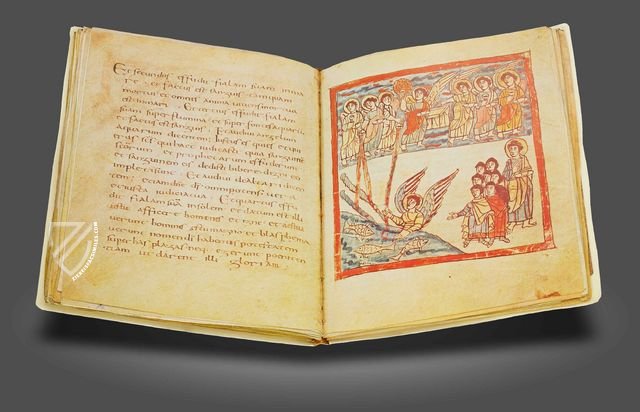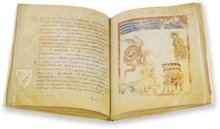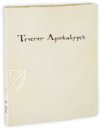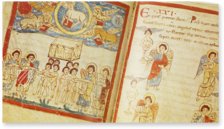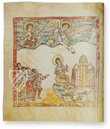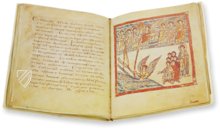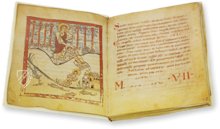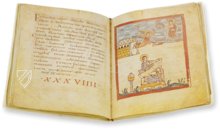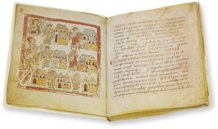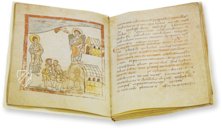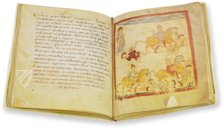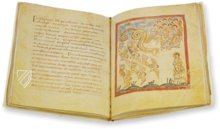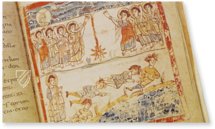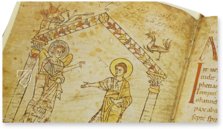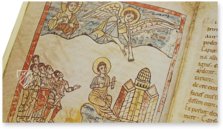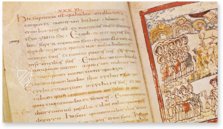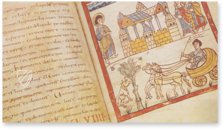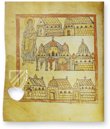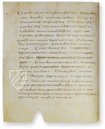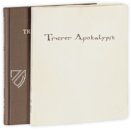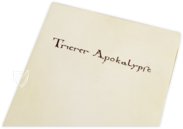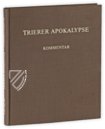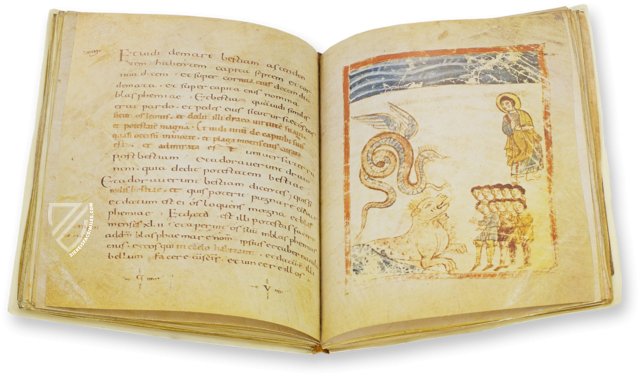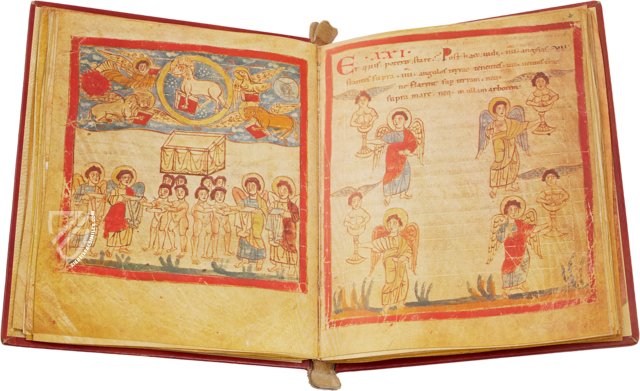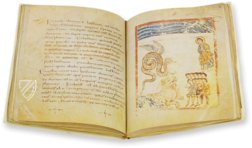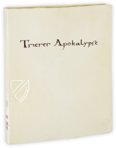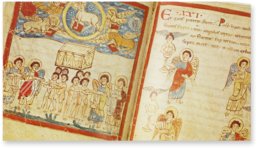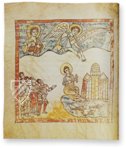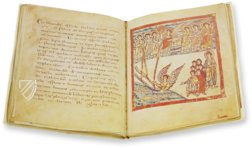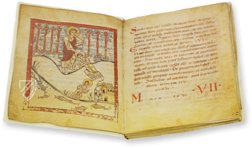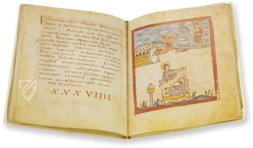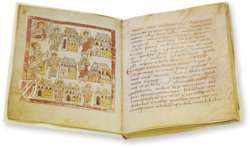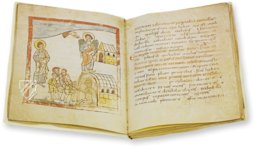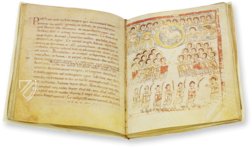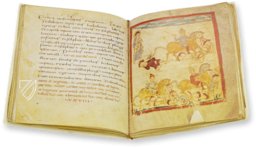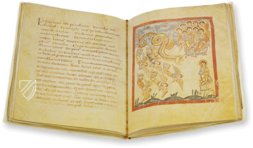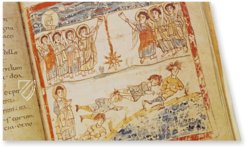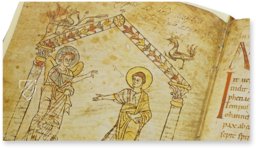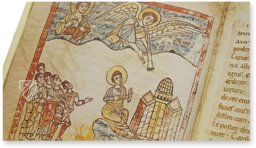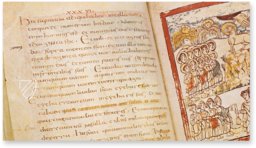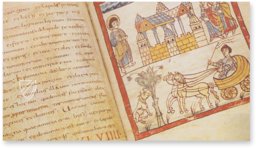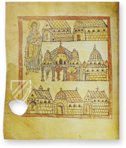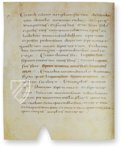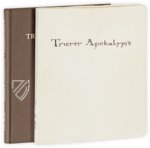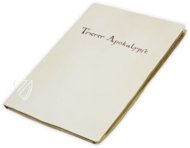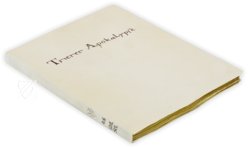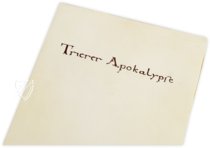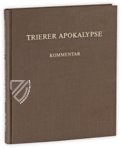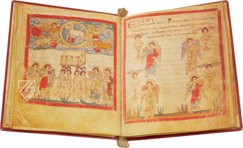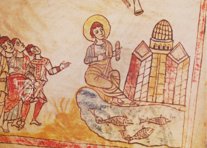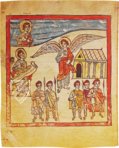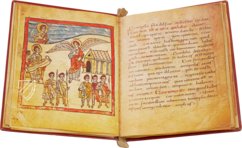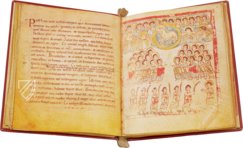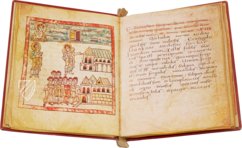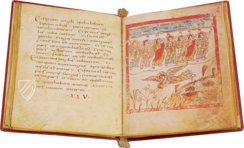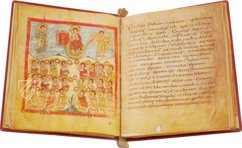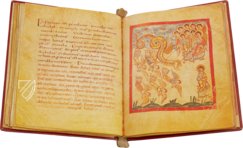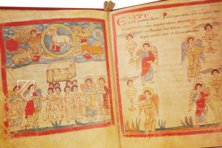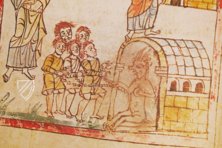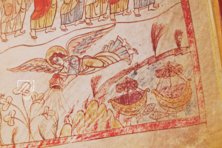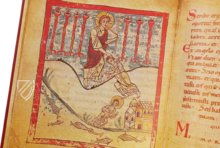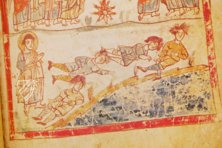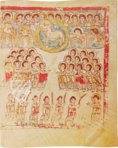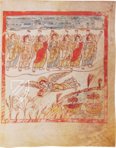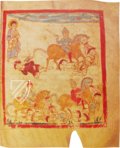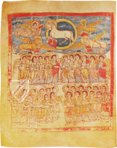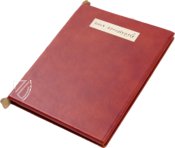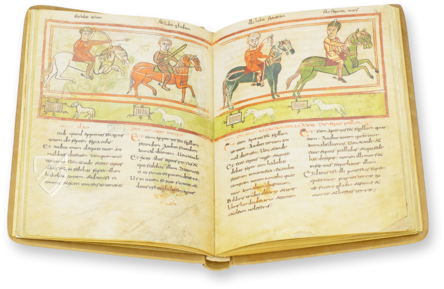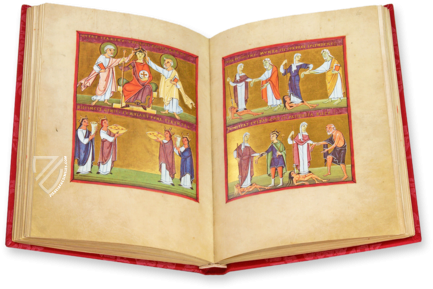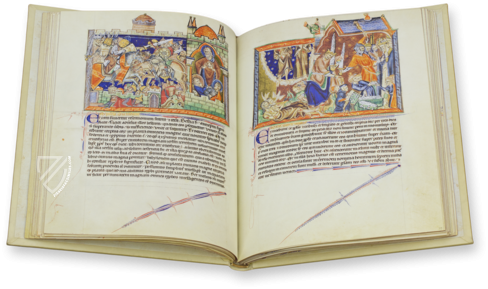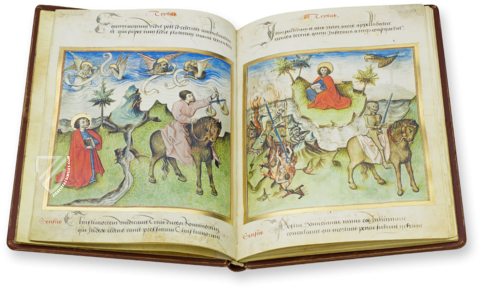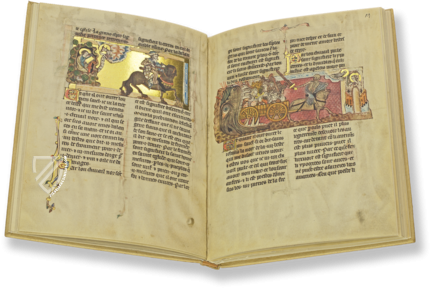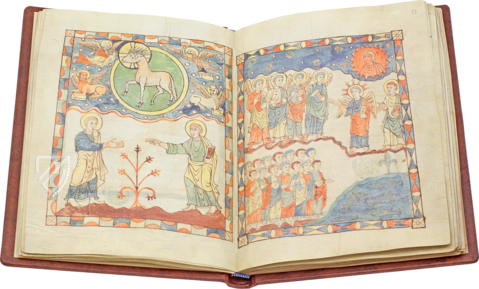Trier Apocalypse
(1,000€ - 3,000€)
The Treves Apocalypse can boast several superlatives: it is the oldest surviving illustrated version of the Revelation of John, it contains the most extensive cycle of images of the last book of the Bible, and serves a unique function as a bridge to the art of Late Antiquity, from which hardly any testimonies have survived directly. Therein lies its inestimable iconographic significance: some of the figures in the 74 full-page miniatures are strikingly reminiscent of pagan antique models. Thus, the goat-headed figure of Satan (fol. 66 and 67) is reminiscent of the pagan god Pan, and similarly an angel (fol. 19v) parallels Nike, the winged ancient goddess of victory. This suggests that the cycle goes back to a sequence of images from Late Antiquity. The text of an Italian Vulgate version, also very early, was revised in the late-11th century.
Trier Apocalypse
The Treves Apocalypse, so-called after its present place of conservation, not only represents the first illustrated version of the Revelation of St. John that we know of, but also features the most comprehensive illustrated cycle of this biblical book that survives from the Early Middle Ages. What makes the Treves Apocalypse (Greek for revelation) so special, is its unique painted decoration which is unparalleled in contemporary Carolingian illumination. Its 74 full-page miniatures in red frames each illustrate a sequence of text from this last book of the New Testament, which has been ascribed to an unknown St. John. The enormous iconographic value of the codex is due to the fact that it is clearly marked by Paleochristian, presumably Roman origins. This makes the Treves Apocalypse one of the few testimonies reflecting late classical artistic creativity, a source to be tapped later by many medieval artists.
The Miniatures
The miniatures of the Treves Apocalypse are colored pen drawings, many of them covering a full page. They are all regularly inserted into the text, each illustrating the preceding section, with the exception of the first one (fol. 1v). The illumination cycle of the Treves Apocalypse is a pure illustration of the text in narrative form and offers no interpretation of the text whatsoever. No reference has so far been found to late classical or early medieval commentaries of the Apocalypse nor to other theological or liturgical scriptures.
Classical Motifs in the World’s Oldest Apocalypse
Many of the illustrations show stunningly obvious parallels to classical motifs. One of them is the goat-headed figure of Satan (fol. 66r and 67r) which goes back to the Greek idea of a deity called Pan, represented with the head of a goat. However, this depiction of Satan in the Treves Apocalypse was made at a time when the antique image of Pan was no longer known and the relation between the Greek goat god and the Christian Satan had fallen into oblivion. What remained in collective memory was Satan’s representation as a goat-like figure. The illustration cycle of the Treves Apocalypse contains numerous other motifs of antique origin, such as the angel on fol. 19v who so stunningly resembles the figures of Nike, the antique goddess of victory. These obvious parallels lead us to assume that the cycle of the Treves Apocalypse goes back to a late antique sequence of images.
A Visionary Book
The Latin text of the Treves Apocalypse follows an early Italian Vulgate and is written in a easily legible Carolingian minuscule script with an amazingly large portion in half-uncial. The text was erased and corrected in many places by a later hand, at the end of the 11th century. Among the books of the New Testament, the significance of the Revelation used to always to be a matter of controversy. Up until the 5th century, the Churches of Syria, Cappadocia and Palestine had not accepted the book as part of the canonical scriptures whereas the Western Church regarded it as an Apostolic Scripture. From the early Paleochristian era, this visionary work was decorated with illustrations, but none of these early illustrated codices survived.
Codicology
- Alternative Titles
- Trierer Apokalypse
Treves Apocalypse - Size / Format
- 148 pages / 26.2 × 21.6 cm
- Origin
- France
- Date
- Around 800
- Epochs
- Style
- Genre
- Language
- Illustrations
- 74 full page miniatures
Trier Apocalypse
John's Message to the Seven Communities of Asia Minor
All located in western Anatolia, the churches of Ephesus, Smyrna, Pergamum, Thyatira, Sardis, Philadelphia, and Laodicea were the largest and most important in the East and it is specifically to these churches that the Book of Revelation is addressed. The so-called Seven Churches of Asia are addressed individually by John throughout Revelation 2 and 3, receiving both encouragement and admonishment. They are represented here with a blend of classical and Carolingian architecture.
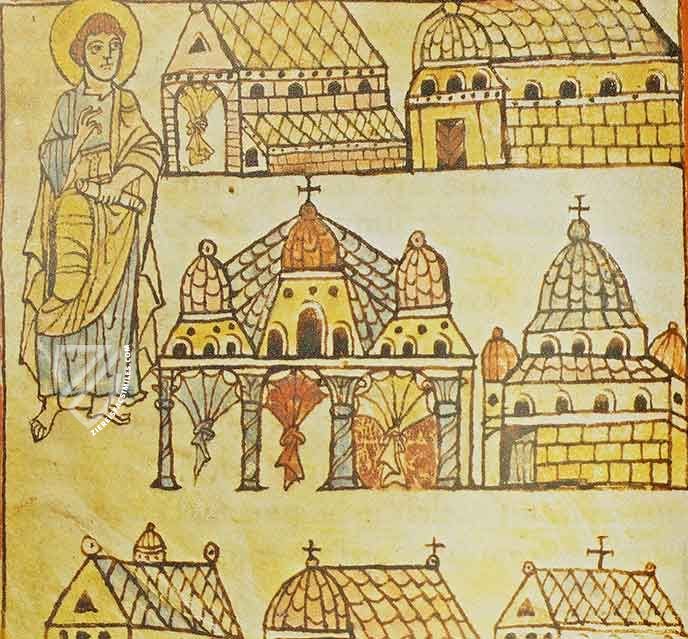
Trier Apocalypse
Vision on Patmos / Son of Man
I, John, both your brother and companion in the tribulation and kingdom and patience of Jesus Christ, was on the island that is called Patmos for the word of God and for the testimony of Jesus Christ. I was in the Spirit on the Lord’s Day, and I heard behind me a loud voice, as of a trumpet, saying, “I am the Alpha and the Omega, the First and the Last,” and, “What you see, write in a book and send it to the seven churches which are in Asia...” (Rev. 1:9–11)
This miniature portrays the moment of John’s inspiration when he received a vision, which would become the Book of Revelation, from Jesus Christ as the “son of man”. Like the rest of the manuscript, this masterful miniature is clearly based on classical forms and mixes Christian and pagan symbolism.
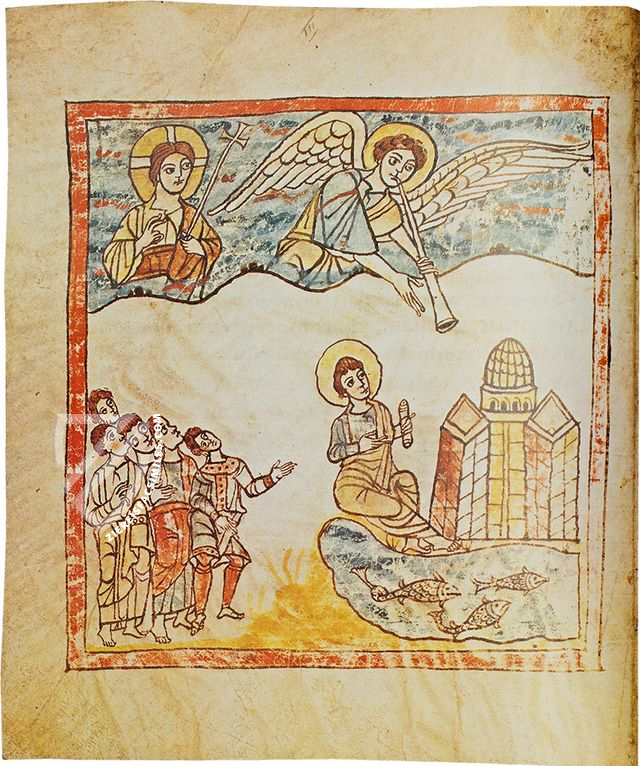
#1 Trierer Apokalypse
Language: German
The extensive expert commentary describes the manuscript and its significance for the history of art. Richard Laufner covers the codicological aspect, while Peter K. Klein writes on the time and place of its making and on the illustration of the codex.
Codicological and palaeographical description by R. Laufner, Trier. Art historical description by P. K. Klein, Bonn. 163 pp. text, 94 illustrations on 52 plates.
(1,000€ - 3,000€)
#2 Trierer Apokalypse (Special Edition)
Language: German
The extensive expert commentary describes the manuscript and its significance for the history of art. Richard Laufner covers the codicological aspect, while Peter K. Klein writes on the time and place of its making and on the illustration of the codex.
Codicological and palaeographical description by R. Laufner, Trier. Art historical description by P. K. Klein, Bonn. 163 pp. text, 94 illustrations on 52 plates.
(1,000€ - 3,000€)
- Treatises / Secular Books
- Apocalypses / Beatus
- Astronomy / Astrology
- Bestiaries
- Bibles / Gospels
- Chronicles / History / Law
- Geography / Maps
- Saints' Lives
- Islam / Oriental
- Judaism / Hebrew
- Single Leaf Collections
- Leonardo da Vinci
- Literature / Poetry
- Liturgical Manuscripts
- Medicine / Botany / Alchemy
- Music
- Mythology / Prophecies
- Psalters
- Other Religious Books
- Games / Hunting
- Private Devotion Books
- Other Genres
- Afghanistan
- Armenia
- Austria
- Belgium
- Belize
- Bosnia and Herzegovina
- China
- Colombia
- Costa Rica
- Croatia
- Cyprus
- Czech Republic
- Denmark
- Egypt
- El Salvador
- Ethiopia
- France
- Germany
- Greece
- Guatemala
- Honduras
- Hungary
- India
- Iran
- Iraq
- Israel
- Italy
- Japan
- Jordan
- Kazakhstan
- Kyrgyzstan
- Lebanon
- Liechtenstein
- Luxembourg
- Mexico
- Morocco
- Netherlands
- Palestine
- Panama
- Peru
- Poland
- Portugal
- Romania
- Russia
- Serbia
- Spain
- Sri Lanka
- Sweden
- Switzerland
- Syria
- Tajikistan
- Turkey
- Turkmenistan
- Ukraine
- United Kingdom
- United States
- Uzbekistan
- Vatican City
- A. Oosthoek, van Holkema & Warendorf
- Aboca Museum
- Ajuntament de Valencia
- Akademie Verlag
- Akademische Druck- u. Verlagsanstalt (ADEVA)
- Aldo Ausilio Editore - Bottega d’Erasmo
- Alecto Historical Editions
- Alkuin Verlag
- Almqvist & Wiksell
- Amilcare Pizzi
- Andreas & Andreas Verlagsbuchhandlung
- Archa 90
- Archiv Verlag
- Archivi Edizioni
- Arnold Verlag
- ARS
- Ars Magna
- ArtCodex
- AyN Ediciones
- Azimuth Editions
- Badenia Verlag
- Bärenreiter-Verlag
- Belser Verlag
- Belser Verlag / WK Wertkontor
- Benziger Verlag
- Bernardinum Wydawnictwo
- BiblioGemma
- Biblioteca Apostolica Vaticana (Vaticanstadt, Vaticanstadt)
- Bibliotheca Palatina Faksimile Verlag
- Bibliotheca Rara
- Boydell & Brewer
- Bramante Edizioni
- Bredius Genootschap
- Brepols Publishers
- British Library
- C. Weckesser
- Caixa Catalunya
- Canesi
- CAPSA, Ars Scriptoria
- Caratzas Brothers, Publishers
- Carus Verlag
- Casamassima Libri
- Centrum Cartographie Verlag GmbH
- Chavane Verlag
- Christian Brandstätter Verlag
- Circulo Cientifico
- Club Bibliófilo Versol
- Club du Livre
- CM Editores
- Collegium Graphicum
- Collezione Apocrifa Da Vinci
- Comissão Nacional para as Comemorações dos Descobrimentos Portugueses
- Coron Verlag
- Corvina
- CTHS
- D. S. Brewer
- Damon
- De Agostini/UTET
- De Nederlandsche Boekhandel
- De Schutter
- Deuschle & Stemmle
- Deutscher Verlag für Kunstwissenschaft
- DIAMM
- Droz
- E. Schreiber Graphische Kunstanstalten
- Ediciones Boreal
- Ediciones Grial
- Ediclube
- Edições Inapa
- Edilan
- Editalia
- Edition Deuschle
- Edition Georg Popp
- Edition Leipzig
- Edition Libri Illustri
- Editiones Reales Sitios S. L.
- Éditions de l'Oiseau Lyre
- Editions Medicina Rara
- Editorial Casariego
- Editorial Mintzoa
- Editrice Antenore
- Editrice Velar
- Edizioni Edison
- Egeria, S.L.
- Eikon Editores
- Electa
- Emery Walker Limited
- Enciclopèdia Catalana
- Eos-Verlag
- Ephesus Publishing
- Ernst Battenberg
- Eugrammia Press
- Extraordinary Editions
- Fackelverlag
- Facsimila Art & Edition
- Facsimile Editions Ltd.
- Facsimilia Art & Edition Ebert KG
- Faksimile Verlag
- Feuermann Verlag
- Folger Shakespeare Library
- Franco Cosimo Panini Editore
- Friedrich Wittig Verlag
- Fundación Hullera Vasco-Leonesa
- G. Braziller
- Gabriele Mazzotta Editore
- Gebr. Mann Verlag
- Gesellschaft für graphische Industrie
- Getty Research Institute
- Giovanni Domenico de Rossi
- Giunti Editore
- Graffiti
- Grafica European Center of Fine Arts
- Guido Pressler
- Guillermo Blazquez
- Gustav Kiepenheuer
- H. N. Abrams
- Harrassowitz
- Harvard University Press
- Helikon
- Hendrickson Publishers
- Henning Oppermann
- Herder Verlag
- Hes & De Graaf Publishers
- Hoepli
- Holbein-Verlag
- Houghton Library
- Hugo Schmidt Verlag
- Idion Verlag
- Il Bulino, edizioni d'arte
- ILte
- Imago
- Insel Verlag
- Insel-Verlag Anton Kippenberger
- Instituto de Estudios Altoaragoneses
- Instituto Nacional de Antropología e Historia
- Introligatornia Budnik Jerzy
- Istituto dell'Enciclopedia Italiana - Treccani
- Istituto Ellenico di Studi Bizantini e Postbizantini
- Istituto Geografico De Agostini
- Istituto Poligrafico e Zecca dello Stato
- Italarte Art Establishments
- Jan Thorbecke Verlag
- Johnson Reprint Corporation
- Josef Stocker
- Josef Stocker-Schmid
- Jugoslavija
- Karl W. Hiersemann
- Kasper Straube
- Kaydeda Ediciones
- Kindler Verlag / Coron Verlag
- Kodansha International Ltd.
- Konrad Kölbl Verlag
- Kurt Wolff Verlag
- La Liberia dello Stato
- La Linea Editrice
- La Meta Editore
- Lambert Schneider
- Landeskreditbank Baden-Württemberg
- Leo S. Olschki
- Les Incunables
- Liber Artis
- Library of Congress
- Libreria Musicale Italiana
- Lichtdruck
- Lito Immagine Editore
- Lumen Artis
- Lund Humphries
- M. Moleiro Editor
- Maison des Sciences de l'homme et de la société de Poitiers
- Manuscriptum
- Martinus Nijhoff
- Maruzen-Yushodo Co. Ltd.
- MASA
- Massada Publishers
- McGraw-Hill
- Metropolitan Museum of Art
- Militos
- Millennium Liber
- Müller & Schindler
- Nahar - Stavit
- Nahar and Steimatzky
- National Library of Wales
- Neri Pozza
- Nova Charta
- Oceanum Verlag
- Odeon
- Orbis Mediaevalis
- Orbis Pictus
- Österreichische Staatsdruckerei
- Oxford University Press
- Pageant Books
- Parzellers Buchverlag
- Patrimonio Ediciones
- Pattloch Verlag
- PIAF
- Pieper Verlag
- Plon-Nourrit et cie
- Poligrafiche Bolis
- Presses Universitaires de Strasbourg
- Prestel Verlag
- Princeton University Press
- Prisma Verlag
- Priuli & Verlucca, editori
- Pro Sport Verlag
- Propyläen Verlag
- Pytheas Books
- Quaternio Verlag Luzern
- Reales Sitios
- Recht-Verlag
- Reichert Verlag
- Reichsdruckerei
- Reprint Verlag
- Riehn & Reusch
- Roberto Vattori Editore
- Rosenkilde and Bagger
- Roxburghe Club
- Salerno Editrice
- Saltellus Press
- Sandoz
- Sarajevo Svjetlost
- Schöck ArtPrint Kft.
- Schulsinger Brothers
- Scolar Press
- Scrinium
- Scripta Maneant
- Scriptorium
- Shazar
- Siloé, arte y bibliofilia
- SISMEL - Edizioni del Galluzzo
- Sociedad Mexicana de Antropología
- Société des Bibliophiles & Iconophiles de Belgique
- Soncin Publishing
- Sorli Ediciones
- Stainer and Bell
- Studer
- Styria Verlag
- Sumptibus Pragopress
- Szegedi Tudomànyegyetem
- Taberna Libraria
- Tarshish Books
- Taschen
- Tempus Libri
- Testimonio Compañía Editorial
- Thames and Hudson
- The Clear Vue Publishing Partnership Limited
- The Facsimile Codex
- The Folio Society
- The Marquess of Normanby
- The Richard III and Yorkist History Trust
- Tip.Le.Co
- TouchArt
- TREC Publishing House
- TRI Publishing Co.
- Trident Editore
- Tuliba Collection
- Typis Regiae Officinae Polygraphicae
- Union Verlag Berlin
- Universidad de Granada
- University of California Press
- University of Chicago Press
- Urs Graf
- Vallecchi
- Van Wijnen
- VCH, Acta Humaniora
- VDI Verlag
- VEB Deutscher Verlag für Musik
- Verlag Anton Pustet / Andreas Verlag
- Verlag Bibliophile Drucke Josef Stocker
- Verlag der Münchner Drucke
- Verlag für Regionalgeschichte
- Verlag Styria
- Vicent Garcia Editores
- W. Turnowski Ltd.
- W. Turnowsky
- Waanders Printers
- Wiener Mechitharisten-Congregation (Wien, Österreich)
- Wissenschaftliche Buchgesellschaft
- Wissenschaftliche Verlagsgesellschaft
- Wydawnictwo Dolnoslaskie
- Xuntanza Editorial
- Zakład Narodowy
- Zollikofer AG

